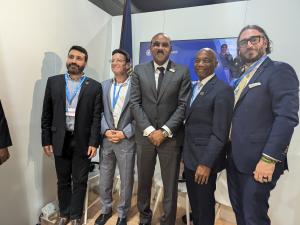
The Electric Aviation Revolution: Charting a Course Toward a Sustainable Future
The aviation industry, once synonymous with innovation, faces an existential challenge: balancing growing demand for air travel with mounting pressure to reduce its environmental impact. Electric aviation, a nascent but rapidly developing sector, promises to reshape the industry by offering sustainable, efficient, and cost-effective solutions for short-haul and regional flights. With several companies pioneering breakthroughs in technology and regulatory progress, the electric aviation revolution is poised to take off—quite literally.
The Sustainability Imperative
Aviation contributes approximately 2-3% of global CO₂ emissions, with short-haul flights emerging as disproportionately harmful. Per passenger mile, these flights rank among the most polluting travel methods, making sustainable alternatives necessary. Electric aircraft, which produce zero in-flight emissions, offer an unprecedented opportunity to mitigate aviation’s environmental footprint. By eliminating jet fuel reliance and leveraging clean energy sources, electric planes could transform how we think about air travel.
The environmental benefits extend beyond carbon emissions. Traditional jet engines are notorious for their noise pollution, affecting communities near airports. Electric motors, by contrast, operate at significantly lower decibel levels, enhancing the feasibility of flights in densely populated areas. For example, Eviation’s Alice, an all-electric aircraft, boasts a noise level of just 75 dB at 300 feet—akin to urban road traffic.
Short-Haul Flights: A Ready Market
Electric aviation’s greatest immediate potential lies in short-haul flights. These routes, spanning 500 nautical miles or less, account for nearly half of global air traffic. Within this segment, 20-30% of flights are under 250 nautical miles. The combination of these factors creates a compelling business case for electric aircraft with shorter ranges.
Unlike long-haul flights, which demand significant advancements in battery technology to achieve feasibility, short-haul routes align well with the current capabilities of electric aviation. Aircraft like the Alice and Electra Aero EL9 are tailored for these missions, offering ranges of 400 km and 1,100 nautical miles, respectively. The economic potential is enormous, as airlines seek to reduce operating costs and meet increasingly stringent environmental regulations.
Technology Driving the Revolution
The promise of electric aviation is underpinned by advances in battery technology, motor efficiency, and hybrid systems.
- Battery Breakthroughs: Batteries are the linchpin of electric aviation. Over the past decade, energy density—measured in watt-hours per kilogram—has steadily improved, and experts anticipate further leaps. Current advancements suggest energy densities will rise from today’s 275 Wh/kg to as high as 500 Wh/kg in the coming years. This growth is critical for increasing flight range and payload capacity.
- Innovative Motor Designs: Electric motors offer significant advantages over traditional jet engines. They contain fewer moving parts, reduce maintenance costs, and provide faster response times for enhanced maneuverability. Designs like the Electra Aero EL9 feature multiple motors along the leading edge of the wings, which improve aerodynamics and reduce takeoff distances. These innovations ensure electric aircraft can perform efficiently even in challenging conditions.
- Hybrid Systems: While fully electric aircraft dominate headlines, hybrid-electric models offer a bridge to long-range sustainability. Turbo generators, which use lightweight gas turbines to generate electricity, can extend the range of electric aircraft while maintaining lower emissions compared to conventional planes. This hybrid approach may prove essential for transitioning larger commercial aircraft to electric propulsion.
Regulatory Challenges
The adoption of electric aviation hinges on navigating complex regulatory landscapes. The Federal Aviation Administration (FAA), tasked with ensuring airworthiness and passenger safety, faces unique challenges in certifying electric aircraft. Unlike traditional planes, electric models often incorporate novel designs and technologies that require rigorous testing and validation.
Companies are pursuing different strategies to expedite regulatory approval. For instance, many are focusing on conventional fixed-wing designs before tackling more complex vertical takeoff and landing (eVTOL) configurations. This pragmatic approach aligns with the FAA’s existing certification framework, allowing earlier market entry.
The initial focus on cargo transport over passenger flights also reflects regulatory realities. Cargo operators like DHL are already integrating electric aircraft into their fleets, using them for regional delivery routes. These applications provide a proving ground for electric aviation technology while avoiding the stringent requirements associated with passenger safety.
Market Momentum
The electric aviation market is buoyed by strong demand and substantial investment. Cargo operators, regional airlines, and even military organizations are placing significant pre-orders for electric aircraft. For example, DHL has partnered with Eviation to deploy Alice for cargo transport, while Electra Aero has secured letters of intent from over 30 customers for more than 1,000 aircraft, representing $4 billion in market value.
Urban Air Mobility (UAM) companies, such as Archer Aviation, are also gaining traction. Their eVTOL designs aim to revolutionize urban transportation by offering air taxi services between city centers and airports. Though still in development, these aircraft promise to alleviate urban congestion and reduce travel times significantly.
Applications and Initial Rollout
Electric aviation’s earliest adopters are likely to be in the cargo and urban mobility sectors, where the benefits of low operating costs and point-to-point capabilities are most pronounced. Key applications include:
- Cargo Transport: Electric aircraft’s payload flexibility and cost efficiency make them ideal for regional cargo routes. Operators can deploy these planes to connect hubs with smaller airports, bypassing congested airspaces and reducing delivery times.
- Urban Air Mobility (UAM): eVTOL aircraft are designed for short trips, such as airport shuttles or intra-city commutes. Their ability to take off and land vertically eliminates the need for large runways, enabling operations from compact urban vertiports.
- Regional Transportation: Electric planes can connect remote areas, providing faster and more sustainable travel options for passengers and goods. This capability is particularly valuable in regions underserved by traditional airlines.
Looking Ahead
The timeline for electric aviation’s widespread adoption is ambitious yet realistic. Some companies anticipate FAA approval and commercial flights as early as 2025. Battery technology is expected to improve at an annual rate of 7%, doubling energy density within the next decade. By the 2030s and 2040s, autonomous electric aircraft could become a reality, further revolutionizing the industry.
Despite these advancements, challenges remain. Scaling production, building charging infrastructure, and achieving public acceptance will require concerted effort. However, the strong market demand, coupled with technological innovation and regulatory progress, suggests that electric aircraft will play a transformative role in aviation’s future.
Conclusion
Electric aviation is no longer a distant dream—it is a rapidly emerging reality with the potential to redefine how we fly. By addressing environmental concerns, reducing noise pollution, and lowering operating costs, electric aircraft offer a compelling solution to the challenges facing the aviation industry. While hurdles remain, the dedication of engineers, regulators, and market leaders ensures that the electric aviation revolution is not just taking off—it is soaring toward a more sustainable future.














